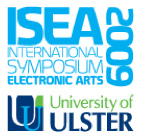 11 AM, August 28th, 2009, Waterfront Hall, Belfast
11 AM, August 28th, 2009, Waterfront Hall, Belfast
“Mechatronic Art: Beyond Craft-Fetishism”
James Coupe
In 1968, art historian Jack Burnham’s seminal essay “Systems Esthetics” was published in Artforum. He attempted to investigate the emergence of art practices that seemed to resist available critical analysis, referring to them as “unobjects”. He identified a shift in art practice from objects to systems, and introduced important criteria for defining “systems art” – work that was open, responsive and interactive with its environment and audience was distinguished from plinth-based sculpture; work that was spread across multiple sites, that used telecommunication hardware and thereby incorporated ‘invisible’ properties was to be seen as a totality, not simply in terms of what could be seen:
Here, change emanates, not from things, but from the way things are done.
This paper examines ‘mechatronic’ art, arguing that Burnham’s observations referred to a new paradigm for art that is only now capable of being fully realized. Interestingly, Burnham’s theories emerged out of sculptural concerns, which are often anathema to many people’s understanding of digital art: Burnham was not referring to screen-based, graphically oriented work, he was talking about physical experiences, embodied and situated in the real world.
In mechatronic art this is explored to the fullest extent, via a dynamic synergy of art, computing and engineering. Artists working within this paradigm often develop custom-built hardware and electronics to control hybrid telematic environments, constructing components that are designed with built-in logical goals. Traditionally in digital art, these kind of algorithmic systems have been implemented using just software, but increasingly artists are working with combinations of hardware and software, essentially allowing each to learn from the other. The knowledge economy involved in building such projects requires artists to work within laboratory environments, sometimes developing new tools and technical solutions that make genuine contributions to allied scientific fields. This multidisciplinary approach has made mechatronic technologies – such as microcontrollers, sensors and actuators – highly accessible, as well as allowing the field to expand quickly from both a conceptual and a technical point of view. Artists operating within this paradigm are finding opportunities to make work that operates and responds to the real world, rather than work that is bound by conventional art structures and materials. As Burnham commented:
Craft-fetishism remains the basis of modern formalism. Instead the significant artist strives to reduce the technical and psychical distance between his artistic output and the productive means of his society. Gradually this strategy transforms artistic and technological decision-making into a single activity.
Mechatronic art is not simply about making work that is ‘interactive’, ‘interdisciplinary’, ‘responsive’, ‘kinetic’, ‘mechanical’, etc. There is also an important aesthetic and theoretical rigor to be taken into consideration. In this paper I will argue that in establishing a critical vocabulary for mechatronic art, it is important for the work to be generative. Simply combining methods, processes and materials from different disciplines is not sufficient: the combination must generate something new that is a necessary function of the art system. Such work involves a vast array of experiments with materials, audience, site, time and space, characterizing a new genre of art that synthesizes knowledge gained from diverse creative fields such as dance, music and literature.